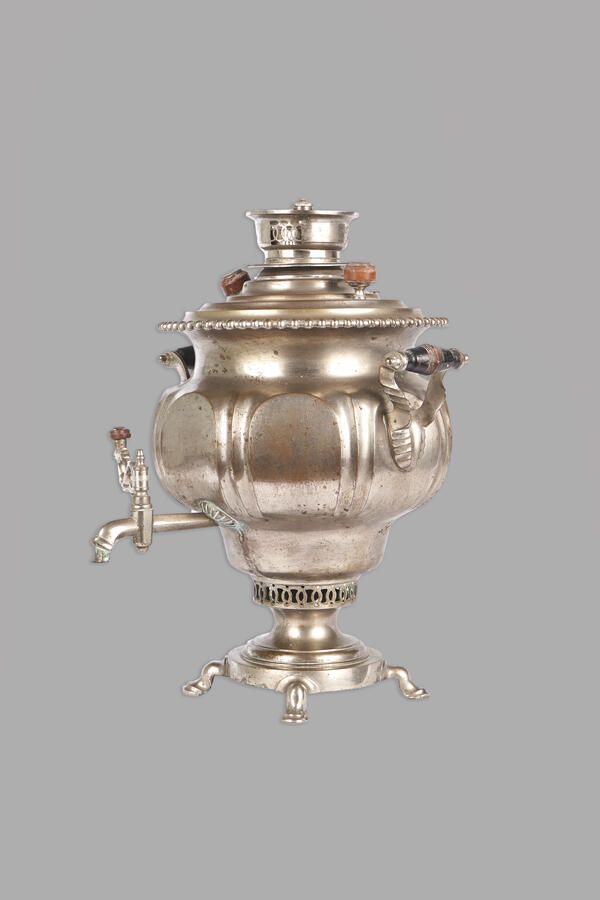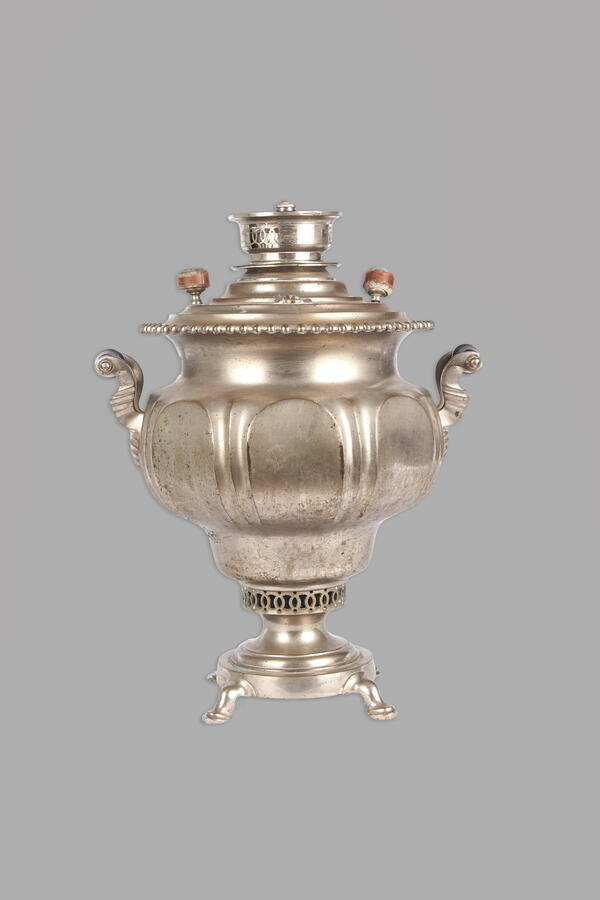The samovar is a symbol of home comfort and family hearth.
Vorontsov samovar
Creation period
the last quarter of the 19th century
Place of сreation
Tula, the Russian Empire
Dimensions
51x38x40 cm
Technique
brass, steel, wood, casting, chasing, turning, tinning, assembling
Collection
Exhibition
2
Open in app#9
A hot samovar hissed comfortably on a clean tablecloth in the dining room…
N.G. Garin-Mikhailovsky
#4
#11
A samovar is a water-heating vessel for tea, mostly made of copper, with a chimney and a fire grate inside.
V.I. Dal, “Explanatory Dictionary of the Living Great Russian Language”.
#12
Indeed, initially the water in the samovar was heated by an internal furnace in the form of a tall tube filled with charcoal. Such samovars were called charcoal or wood samovars. A samovar of this type is on display at the Novorossiysk Historical Museum-Reserve.
This charcoal and wood samovar is faceted and turnip-shaped. It was produced by the factory of Nikolay Alekseevich Vorontsov. Instead of mass production, the merchant Vorontsov chose to produce elite samovars designed to satisfy the refined tastes of the aristocracy and nobility. In the middle of the 19th century, Vorontsov’s products were the leaders of the samovar market in Russia.
The body of the samovar is rounded and turnip-shaped. It has eight oval facets, which connect at the top and extend into a round, multi-stage tray with four scroll legs at the bottom. Inside the body there is a fire grate for coal with an openwork lattice in the lower part and a movable flat round lid with a handle. In the upper part of the body, there are two fixed handles with a figured frame and wooden handles. In the lower part of the body, there is a multifaceted lock insert for attaching a figured faucet. The elongated faucet flares towards the end and has a locking rotary key (screw). In the upper part of the body, there is a circle in the form of a cast ring, which serves as a support for the lid. The side of the ring is decorated with a convex pattern in the form of rounded protrusions. The lid is round, multi-stage, with a hole in the center, equal in diameter to the pipe of the fire grate located inside, and an air vent (smoke, steamer) to release steam after the samovar boils. There are two handles on the lid. The top of the samovar is crowned with a round flat ring with a burner and a cap. At the transition from the body to the tray, there is a round neck in the form of an openwork lattice, through which air enters the fire grate to maintain the combustion process.
This charcoal and wood samovar is faceted and turnip-shaped. It was produced by the factory of Nikolay Alekseevich Vorontsov. Instead of mass production, the merchant Vorontsov chose to produce elite samovars designed to satisfy the refined tastes of the aristocracy and nobility. In the middle of the 19th century, Vorontsov’s products were the leaders of the samovar market in Russia.
The body of the samovar is rounded and turnip-shaped. It has eight oval facets, which connect at the top and extend into a round, multi-stage tray with four scroll legs at the bottom. Inside the body there is a fire grate for coal with an openwork lattice in the lower part and a movable flat round lid with a handle. In the upper part of the body, there are two fixed handles with a figured frame and wooden handles. In the lower part of the body, there is a multifaceted lock insert for attaching a figured faucet. The elongated faucet flares towards the end and has a locking rotary key (screw). In the upper part of the body, there is a circle in the form of a cast ring, which serves as a support for the lid. The side of the ring is decorated with a convex pattern in the form of rounded protrusions. The lid is round, multi-stage, with a hole in the center, equal in diameter to the pipe of the fire grate located inside, and an air vent (smoke, steamer) to release steam after the samovar boils. There are two handles on the lid. The top of the samovar is crowned with a round flat ring with a burner and a cap. At the transition from the body to the tray, there is a round neck in the form of an openwork lattice, through which air enters the fire grate to maintain the combustion process.
#13
1 / 3
Vorontsov samovar
#6
Ministry of Culture of the Russian Federation
read morehide
00:00
00:00
1x
Vorontsov samovar
Creation period
the last quarter of the 19th century
Place of сreation
Tula, the Russian Empire
Dimensions
51x38x40 cm
Technique
brass, steel, wood, casting, chasing, turning, tinning, assembling
Collection
Exhibition
2
Open in app
Share





